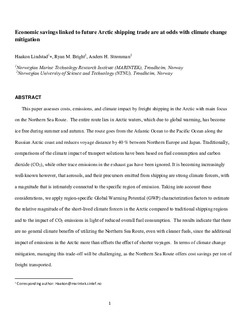| dc.contributor.author | Lindstad, Haakon | |
| dc.contributor.author | Bright, Ryan M. | |
| dc.contributor.author | Strømman, Anders Hammer | |
| dc.date.accessioned | 2017-11-03T10:15:07Z | |
| dc.date.available | 2017-11-03T10:15:07Z | |
| dc.date.created | 2015-10-05T11:57:15Z | |
| dc.date.issued | 2016 | |
| dc.identifier.citation | Transport Policy. 2016, 45 24-30. | nb_NO |
| dc.identifier.issn | 0967-070X | |
| dc.identifier.uri | http://hdl.handle.net/11250/2463908 | |
| dc.description.abstract | This paper assesses costs, emissions, and climate impact by freight shipping in the Arctic with main focus on the Northern Sea Route. The entire route lies in Arctic waters, which due to global warming, has become ice free during summer and autumn. The route goes from the Atlantic Ocean to the Pacific Ocean along the Russian Arctic coast and reduces voyage distance by 40 % between Northern Europe and Japan. Traditionally, comparisons of the climate impact of transport solutions have been based on fuel consumption and carbon dioxide (CO2), while other trace emissions in the exhaust gas have been ignored. It is becoming increasingly well-known however, that aerosols, and their precursors emitted from shipping are strong climate forcers, with a magnitude that is intimately connected to the specific region of emission. Taking into account these considerations, we apply region-specific Global Warming Potential (GWP) characterization factors to estimate the relative magnitude of the short-lived climate forcers in the Arctic compared to traditional shipping regions and to the impact of CO2 emissions in light of reduced overall fuel consumption. The results indicate that there are no general climate benefits of utilizing the Northern Sea Route, even with cleaner fuels, since the additional impact of emissions in the Arctic more than offsets the effect of shorter voyages. In terms of climate change mitigation, managing this trade-off will be challenging, as the Northern Sea Route offers cost savings per ton of freight transported. | nb_NO |
| dc.language.iso | eng | nb_NO |
| dc.publisher | Elsevier | nb_NO |
| dc.rights | Attribution-NonCommercial-NoDerivatives 4.0 Internasjonal | * |
| dc.rights.uri | http://creativecommons.org/licenses/by-nc-nd/4.0/deed.no | * |
| dc.title | Economic savings linked to future Arctic shipping are at odds with climate change mitigation | nb_NO |
| dc.type | Journal article | nb_NO |
| dc.type | Peer reviewed | nb_NO |
| dc.description.version | acceptedVersion | nb_NO |
| dc.source.pagenumber | 24-30 | nb_NO |
| dc.source.volume | 45 | nb_NO |
| dc.source.journal | Transport Policy | nb_NO |
| dc.identifier.doi | 10.1016/j.tranpol.2015.09.002 | |
| dc.identifier.cristin | 1278386 | |
| dc.relation.project | Norges forskningsråd: 239113 | nb_NO |
| dc.description.localcode | © 2015. This is the authors’ accepted and refereed manuscript to the article. This manuscript version is made available under the CC-BY-NC-ND 4.0 license http://creativecommons.org/licenses/by-nc-nd/4.0/ | nb_NO |
| cristin.unitcode | 194,64,25,0 | |
| cristin.unitname | Institutt for energi- og prosessteknikk | |
| cristin.ispublished | true | |
| cristin.fulltext | postprint | |
| cristin.qualitycode | 1 | |

